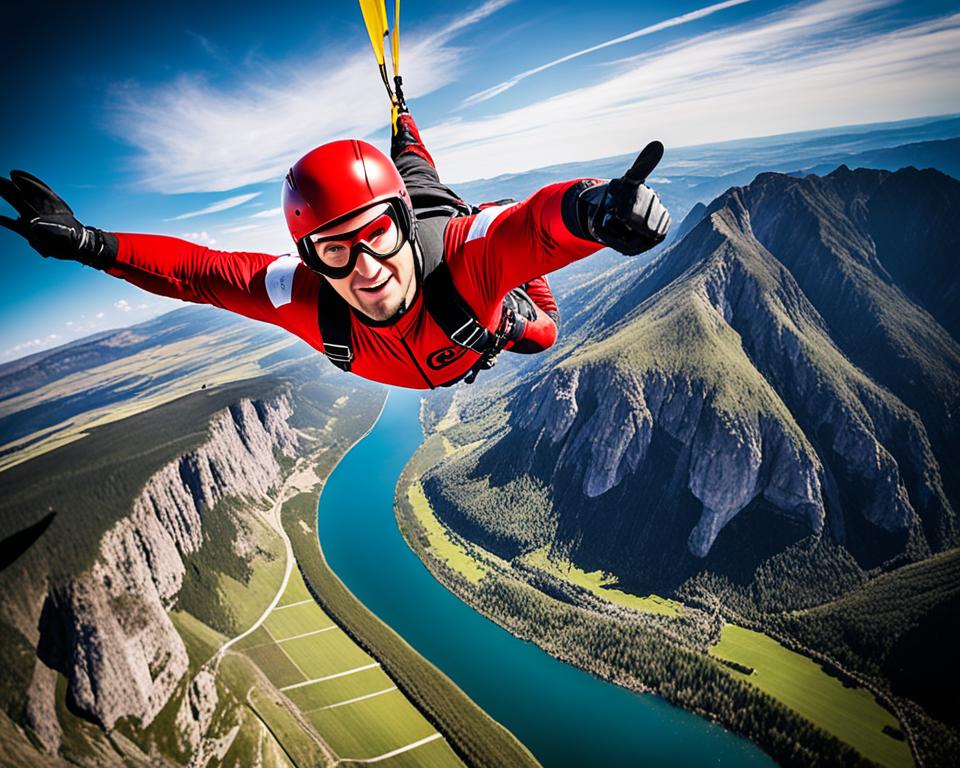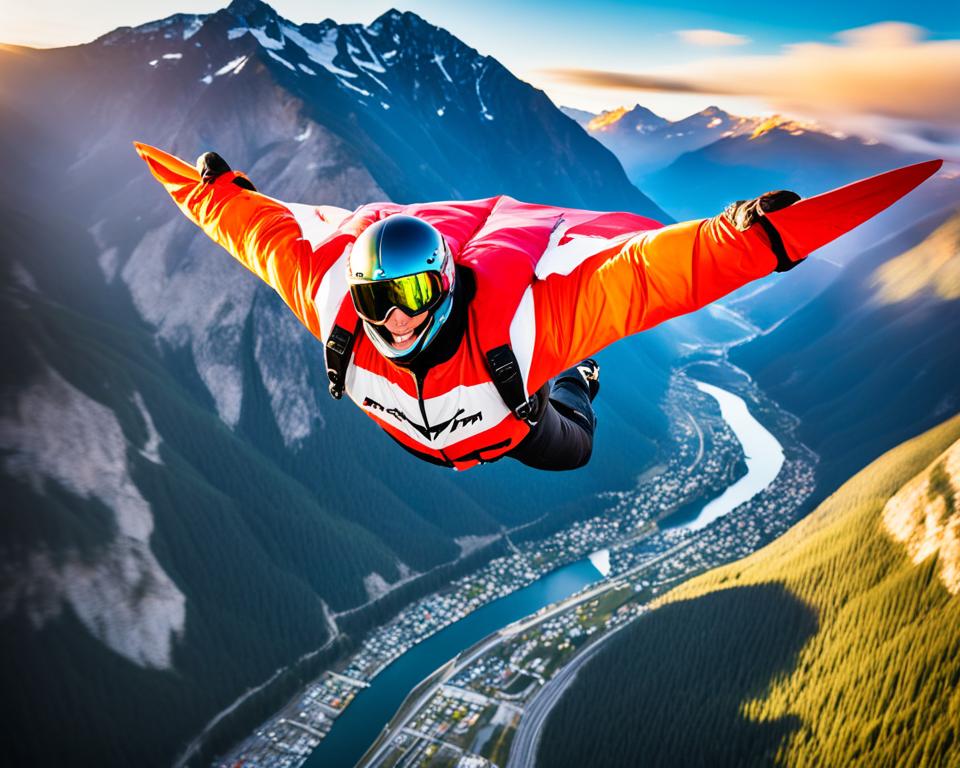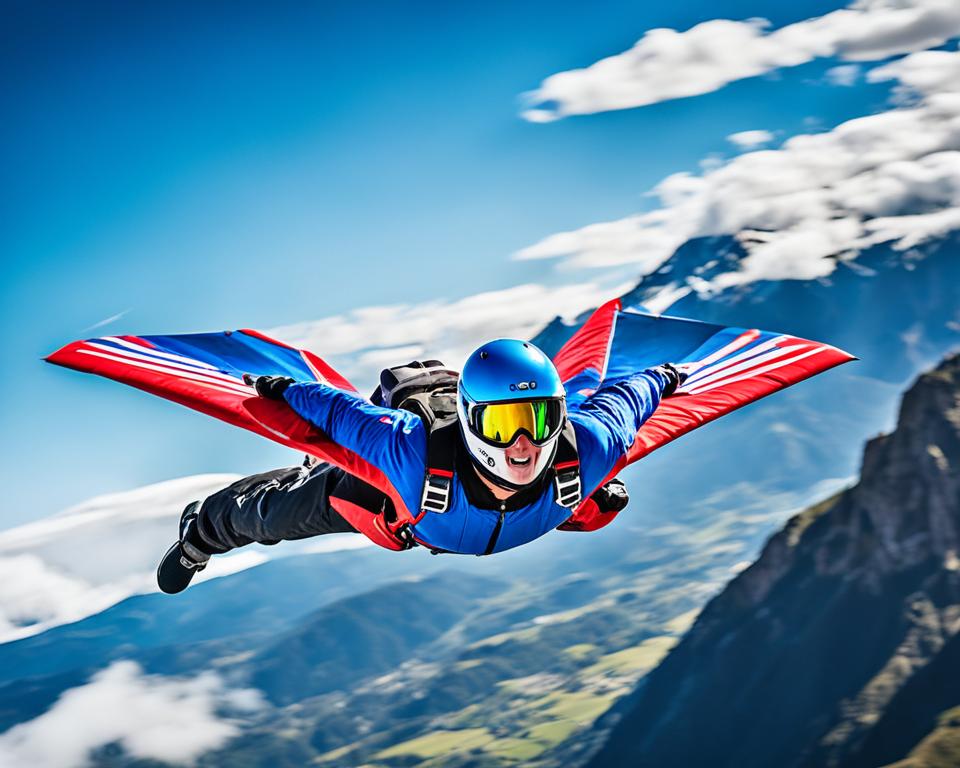
Air extreme sports encompass a thrilling world of aerial adventures that captivate the senses and push the boundaries of human flight. From the adrenaline-fueled freefall of skydiving to the graceful glides of hang gliding, these activities offer a unique, exhilarating experience that has attracted a dedicated community of enthusiasts. This article delves into the various disciplines that make up the air extreme sports landscape, exploring their origins, the equipment and techniques involved, and the allure that draws adventurers to these pursuits. Whether you’re a seasoned air sports enthusiast or a newcomer seeking an unforgettable aerial experience, this comprehensive guide will provide insights and inspiration to embark on your own thrilling journey.
Read interesting things at : web-quanto
Key Takeaways
- Air extreme sports encompass a wide range of thrilling aerial activities, from skydiving and base jumping to hang gliding and paragliding.
- These sports offer a unique, adrenaline-fueled experience that has captivated a dedicated community of enthusiasts.
- The article explores the origins, equipment, and techniques involved in various air extreme sports disciplines.
- Whether you’re a seasoned air sports enthusiast or a newcomer, this guide provides insights and inspiration to embark on your own thrilling aerial adventure.
- Safety and proper training are paramount in the world of air extreme sports.
Air Extreme Sports: A Thrilling Aerial Pursuit
Air extreme sports are a captivating and rapidly evolving segment of the adventure sports industry, offering thrill-seekers a chance to defy gravity and experience the exhilaration of human flight. These activities have their roots in the pioneering spirit of early aviators and adventurers, who sought to push the boundaries of what was possible in the sky.
The Adrenaline-Fueled World of Air Sports
From the adrenaline-pumping freefall of skydiving to the graceful glides of hang gliding, the air extreme sports landscape is a tapestry of thrilling disciplines that captivate the senses and challenge the limits of human capabilities. Whether it’s the pure thrill of base jumping or the mesmerizing beauty of paragliding, these pursuits offer a unique and unforgettable aerial experience.
Exploring the Different Disciplines and Their Origins
The world of air extreme sports encompasses a diverse array of disciplines, each with its own distinct history and set of unique challenges. From the cutting-edge technology behind wingsuit flying to the science-driven artistry of bungee jumping, these activities have evolved over time, driven by the relentless pursuit of innovation and the human desire to conquer the skies.
Similarly, the origins of air extreme sports can be traced back to the pioneering efforts of visionary individuals who dared to push the boundaries of what was thought possible. From the early experiments with sky surfing to the development of high-performance speed flying equipment, the evolution of these sports has been marked by a constant drive to explore new frontiers and redefine the limits of human flight.
Skydiving: The Ultimate Freefall Experience
Skydiving is one of the most iconic and exhilarating air extreme sports, offering participants the opportunity to experience the pure thrill of freefall. During a skydive, individuals leap from an aircraft, typically an airplane or helicopter, and plummet earthward at terminal velocity, reaching speeds of up to 200 mph.
The rush of adrenaline and the sensation of defying gravity are what draw skydiving enthusiasts to this captivating pursuit. As they hurtle towards the ground, skydivers can savor the breathtaking views and the incredible feeling of freedom that comes with freefall. The sport requires specialized equipment, including a parachute system, and extensive training to ensure the safety and proficiency of participants.
Whether it’s the thrill of the jump, the serenity of the descent, or the sense of accomplishment upon landing, skydiving offers an unparalleled experience that has captured the imagination of adventure-seekers worldwide. From the first-time jumper to the seasoned parachuting veteran, the allure of this air extreme sport continues to draw in a growing community of enthusiasts.
BASE Jumping: Leaping into the Unknown
BASE jumping, an acronym that stands for Building, Antenna, Span, and Earth, is an extreme form of parachuting that involves leaping from fixed objects rather than an aircraft. BASE jumpers use specially designed parachutes and other specialized equipment to safely navigate their descent from buildings, antennas, bridges, or natural formations like cliffs and mountains.
The Risks and Rewards of BASE Jumping
The allure of BASE jumping lies in the sheer thrill of plunging from fixed objects, defying gravity and experiencing the rush of freefall. However, this sport is also known for its inherent risks, as BASE jumpers must navigate complex maneuvers and environmental factors to ensure a safe landing. Proper training, specialized gear, and a deep understanding of the sport’s technicalities are essential for BASE jumpers to mitigate the dangers and maximize the rewards of this exhilarating pursuit.
While the risks associated with BASE jumping are significant, the rewards for those who master the sport can be immense. The sense of freedom and adrenaline-fueled euphoria that comes with leaping from fixed objects and soaring through the air is unparalleled, drawing a dedicated community of thrill-seekers and adventure enthusiasts to this extreme sport.
| Key Considerations for BASE Jumping | Details |
|---|---|
| Equipment | Specialized parachutes, helmets, and other safety gear designed for BASE jumping |
| Training | Extensive skydiving experience and thorough instruction in BASE jumping techniques |
| Environmental Factors | Wind conditions, terrain, and obstacles that can impact the jump and landing |
| Legal Regulations | Varying laws and regulations governing BASE jumping in different regions |
As with any extreme sport, BASE jumping requires a deep respect for the inherent risks and a dedication to safety. By prioritizing proper training, using the right equipment, and carefully evaluating environmental conditions, BASE jumpers can explore the boundaries of human flight while mitigating the dangers that come with this thrilling pursuit.
Hang Gliding: Soaring with the Wind
Hang gliding is a captivating air sport that allows participants to experience the thrill of silent, wind-powered flight. Hang gliders are lightweight, fabric-and-frame aircraft that are launched by running off a hill or cliff, harnessing the power of the wind to achieve lift and soar gracefully through the air.
The Thrill of Silent Flight
The beauty of hang gliding lies in the serene, silent experience of flight. As the pilot launches into the sky, the only sound is the gentle whisper of the wind, creating a sense of peaceful tranquility that is unparalleled in other air sports. Hang gliders glide effortlessly, relying on the natural currents and thermals to navigate the skies, allowing pilots to enjoy a truly immersive and meditative experience.
Essential Equipment and Safety Precautions
Ensuring the safety of hang gliding participants is of paramount importance. Pilots must undergo rigorous training and certification to master the art of launching, controlling, and landing the aircraft. Additionally, the hang glider itself is equipped with a range of safety features, including a sturdy frame, a flexible wing, and a harness system that securely supports the pilot.
Regular inspections and maintenance of the hang glider’s components are crucial to maintaining airworthiness and mitigating the risks associated with this thrilling air sport. Responsible pilots prioritize safety by adhering to local regulations, practicing in appropriate conditions, and always wearing the necessary protective gear, such as helmets and gloves.
Paragliding: Enjoying the Bird’s Eye View
Paragliding is another captivating air sport that allows individuals to experience the world from a bird’s eye perspective. Unlike hang gliders, paragliders are essentially steerable parachutes that are launched by running down a hill or being towed into the air behind a vehicle or winch system. This unique mode of flight provides a serene and tranquil experience, offering paragliding enthusiasts a chance to soar effortlessly while drinking in the stunning vistas unfolding beneath them.
Mastering the Art of Paragliding
Becoming a skilled paraglider requires a dedicated commitment to mastering the art and technique of this sport. Aspiring pilots must undergo extensive training, learning how to efficiently launch, control, and land their paragliders with precision and grace. From understanding the nuances of wind currents and thermal patterns to developing the reflexes necessary to navigate changing conditions, the journey to become a proficient paragliding pilot is one of continuous learning and practice.
The reward for those who commit to this pursuit, however, is the opportunity to soar high above the earth, taking in a breathtaking bird’s eye view of the landscape below. Paragliding offers a unique and serene aerial experience, allowing adventurers to commune with nature and experience the pure freedom of flight in a way that few other sports can match.
Wingsuit Flying: Defying Gravity with Style
Wingsuit flying, also known as “birdman flying,” is an exhilarating air sport that takes human flight to new heights. Wingsuit pilots wear specialized suits equipped with fabric wings that extend between the arms and legs, allowing them to glide through the air at high speeds while maintaining a degree of control and maneuverability.
The Cutting-Edge Technology Behind Wingsuits
The evolution of wingsuit technology has been a driving force behind the sport’s progression. Advances in materials, aerodynamics, and design have enabled wingsuits to become increasingly efficient and maneuverable. Designers rely on computational fluid dynamics and wind tunnel testing to optimize the suit’s shape and performance, ensuring that wingsuit pilots can soar through the air with precision and control.
Training and Preparation for Wingsuit Flying
Wingsuit flying requires extensive training and preparation to ensure the safety and skill of the pilots. Aspiring wingsuit flyers must undergo thorough training in skydiving and parachute handling before progressing to wingsuit flights. This includes gaining experience in freefall, learning the proper deployment techniques, and mastering the art of canopy control. Only after demonstrating a high level of proficiency and completing numerous skydives can individuals transition into the specialized world of wingsuit flying.

Bungee Jumping: Embracing the Freefall Thrill
Bungee jumping, while not strictly an “air” sport, is nonetheless a thrilling aerial adventure that has captured the imagination of thrill-seekers worldwide. The experience of plunging headfirst into a seemingly endless freefall, only to be gently pulled back upwards by a strong, elastic cord, is both exhilarating and awe-inspiring.
The Science Behind Bungee Jumping
The allure of bungee jumping lies in the intricate interplay of physics and human physiology. As the jumper leaps from the platform, they experience a rapid acceleration due to the Earth’s gravitational pull, reaching terminal velocity within seconds. The science behind this thrilling descent involves the principles of gravity, momentum, and the dynamic properties of the bungee cord.
As the jumper plummets, the bungee cord stretches, absorbing the kinetic energy and gradually slowing the descent. The cord’s elasticity and the jumper’s weight create a unique oscillating motion, where the jumper is gently pulled back upwards, only to repeat the cycle until the energy is dissipated. This carefully engineered system ensures a safe and controlled landing, allowing participants to savor the heart-pounding rush of the freefall.
The art of bungee jumping requires precise calculations, extensive training, and the use of specialized equipment to ensure the safety and thrill of the experience. By understanding the underlying science behind this aerial adventure, enthusiasts can better appreciate the complexities and the allure of this unique pursuit.
Sky Surfing: Riding the Clouds
Sky surfing, a captivating hybrid of skydiving and surfing, has evolved into a thrilling air sport that captivates adventure enthusiasts. This exhilarating discipline combines the adrenaline-fueled freefall of skydiving with the grace and style of wave riding, allowing sky surfers to perform acrobatic maneuvers and stunts while cascading through the air.
The Evolution of Sky Surfing
The origins of sky surfing can be traced back to the late 1980s, when pioneering skydiving enthusiasts began experimenting with various ways to add an extra dimension to their freefall experiences. Inspired by the fluid movements and tricks of surfing, they began experimenting with specialized boards that could be strapped to their feet, enabling them to perform aerial maneuvers and stunts during the descent.
As the sport evolved, sky surfing equipment and techniques continued to advance, with the development of more streamlined and maneuverable boards, as well as specialized training and safety protocols. Today, sky surfing has become a highly specialized discipline within the world of air extreme sports, attracting a dedicated community of thrill-seekers who push the boundaries of human flight.
Safety Considerations for Sky Surfing
Given the inherent risks and demands of sky surfing, safety is of paramount importance for practitioners of this exhilarating air sport. Sky surfers must undergo rigorous training, mastering the techniques and equipment necessary to perform their stunts with precision and control. Additionally, the maintenance and inspection of specialized sky surfing gear is critical, ensuring that each element is in optimal condition to withstand the stresses of freefall and aerial maneuvers.
Furthermore, sky surfing enthusiasts must adhere to strict safety protocols, such as carefully monitoring weather conditions, maintaining situational awareness, and coordinating their jumps with experienced spotters and ground support teams. By prioritizing safety and adhering to best practices, sky surfers can minimize the risks associated with this thrilling aerial pursuit and focus on the pure joy of riding the clouds.
Speed Flying: Pushing the Limits of Aerodynamics
Speed flying, a thrilling variant of paragliding, is an air sport that pushes the boundaries of aerodynamics and human flight. Adrenaline-seeking enthusiasts of this extreme aerial pursuit utilize specialized, high-performance wings designed to achieve blistering speeds of up to 100 mph while maintaining a high degree of control and maneuverability.
The Need for Speed: Adrenaline-Pumping Experiences
The allure of speed flying lies in the pure, unadulterated rush of accelerating through the sky at breakneck speeds. As speed flyers soar through the air, they harness the principles of aerodynamics to their advantage, utilizing the specialized wings’ unique design and construction to generate lift and power.
The adrenaline-fueled experiences of speed flying are unparalleled, as participants navigate tight turns, steep dives, and other technical maneuvers while maintaining complete control of their high-performance wings. This blend of speed, agility, and precision is what draws many thrill-seekers to this captivating air sport.

| Key Aspects of Speed Flying | Description |
|---|---|
| Wing Design | Speed flying wings are engineered with a focus on aerodynamics, featuring a more compact and streamlined shape compared to traditional paragliding wings. This design enables higher speeds while maintaining stability and control. |
| Piloting Techniques | Speed flyers must master a range of advanced techniques, including precise body positioning, weight shifting, and rapid decision-making to navigate the high-speed environment safely and effectively. |
| Safety Considerations | Given the extreme speeds involved, speed flying requires extensive training, specialized equipment, and a deep understanding of meteorological conditions and terrain to mitigate the inherent risks associated with this adrenaline-pumping air sport. |
The Allure of Air Extreme Sports
The allure of air extreme sports lies in their ability to captivate the senses and challenge the boundaries of human capabilities. For many participants, the pursuit of these aerial adventures represents a profound personal journey, one of overcoming fear, embracing the rush of adrenaline, and experiencing a deep connection with the natural world.
Overcoming Fear and Embracing the Rush
Engaging in air extreme sports requires a certain level of courage, as participants must confront and overcome their own fears to fully embrace the thrill of these activities. Whether it’s the heart-pounding freefall of skydiving or the graceful soaring of hang gliding, the act of pushing one’s limits and defying gravity can be both exhilarating and deeply transformative.
The Community and Culture of Air Sports Enthusiasts
Beyond the individual challenge, the air extreme sports community fosters a unique culture of camaraderie, shared passions, and mutual support. Enthusiasts from all walks of life come together to share their experiences, exchange knowledge, and inspire one another to push the boundaries of what’s possible. This vibrant community is a crucial part of the allure, offering a sense of belonging and a shared appreciation for the beauty and excitement of human flight.
Big Red Machine Hall of Famers: Celebrating Baseball Legends
Safety First: Essential Precautions for Air Sports
Ensuring the safety of participants is of paramount importance in the world of air sports. While the thrill and excitement of these pursuits are undeniable, they also carry inherent risks that must be carefully managed through proper training, rigorous safety protocols, and meticulous equipment maintenance.
Proper Training and Certification
Aspiring air sports enthusiasts must undergo comprehensive training and obtain the necessary certifications before engaging in these activities. Proper instruction in techniques, equipment usage, and emergency procedures is crucial to developing the skills and knowledge required to navigate the complexities of air sports safely. Reputable schools and instructors provide extensive theoretical and practical training, ensuring participants are well-prepared for the demands of their chosen discipline.
Equipment Maintenance and Inspection
The specialized equipment used in air sports, such as parachutes, harnesses, and wingsuits, requires diligent maintenance and regular inspection to ensure its integrity and reliability. Training in equipment care and regular checks by qualified professionals are essential to mitigate the risks associated with equipment failure. Adhering to manufacturer guidelines and industry best practices is crucial to maintaining the safety and performance of all air sports gear.
Destination Hotspots for Air Extreme Sports
The world is home to a multitude of breathtaking destinations that have become hotspots for air extreme sports enthusiasts. From iconic skydiving and BASE jumping sites to premier hang gliding and paragliding locations, these geographic wonders offer the perfect settings for adventurers to explore the limits of human flight.
Popular Locations for Skydiving and BASE Jumping
Skydiving and BASE jumping have captivated thrill-seekers around the globe, and certain destinations have gained a reputation as must-visit locations for these adrenaline-fueled pursuits. Places like Interlaken, Switzerland, and Moab, Utah, in the United States, are renowned for their stunning landscapes and ideal conditions for skydiving. Meanwhile, BASE jumping enthusiasts flock to iconic sites like the Kjerag Bolt in Norway and the Petronas Towers in Malaysia to experience the rush of leaping from fixed objects.
Prime Sites for Hang Gliding and Paragliding
Soaring through the skies with the grace and power of a bird is the allure of hang gliding and paragliding, and adventurers have discovered exceptional destinations to indulge in these aerial sports. The coastal cliffs of Rio de Janeiro, Brazil, and the Dolomites in Italy offer premier launch sites and thermal conditions for hang glider pilots to take to the skies. Paragliding enthusiasts, on the other hand, often gravitate towards locations like Pokhara, Nepal, and the Swiss Alps, where the combination of picturesque scenery and reliable wind patterns create an unparalleled experience.






